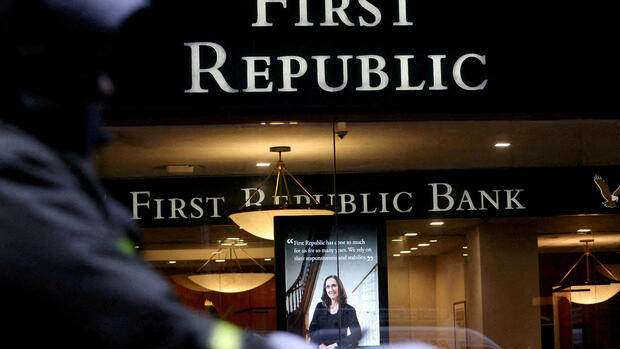new York The bank run at the First Republic Bank (FRB) from San Francisco was apparently more dramatic than initially assumed. In March, customers of the institute withdrew deposits of a good 100 billion dollars, as the bank announced on Monday evening when it published its quarterly figures. Total deposits now stand at $104.5 billion and include $30 billion that 11 major US banks had parked with the First Republic in mid-March. It was an unusual initiative designed to boost confidence in the bank.
But concerns about the institute’s stability are now back. The stock fell more than 20 percent in after-hours trading and has lost around 90 percent of its value since the beginning of the year. The bank announced that it would cut every fourth job. The management around CEO Mike Roffler was surprisingly taciturn at the important analyst conference following the quarterly results. It lasted just under a quarter of an hour and no questions were allowed.
For weeks, First Republic Bank has been looking for a buyer or “other strategic options,” as the bank puts it. But a solution is not yet in sight. The money house came under pressure after the bankruptcy of the Silicon Valley Bank (SVB) and the New York Signature Bank. Like the SVB, First Republic had a large proportion of wealthy customers who quickly withdrew their deposits for fear of spillover effects. In the US, deposits are insured up to $250,000 per customer per bank. Mark Zuckerberg is also said to have been a customer of the First Republic, as reported by the Wall Street Journal. The bank is said to have given him a mortgage.
Outflows slowed significantly in April, First Republic assured on Monday. The bank lost only 1.7 percent of its deposits by last Friday. The situation has thus largely stabilized. Quarterly profit fell 33 percent to $269 million. Earnings fell 13.4 percent to $1.2 billion.
According to industry experts, regional banks are facing difficult times. The rising interest rates of the US Federal Reserve (Fed) have led to sometimes significant book losses in the bond portfolios of the banks. A number of smaller institutions reported in the first quarter that customers withdrew deposits.
Additional costs due to more regulation
As a result, they lose a cheap source of funding that was once a cornerstone of their business model. “Regional banks will have to pay significantly higher interest rates to savers to retain them or attract new customers,” said Rebel Cole, professor of finance at Florida Atlantic University. Institutions also have to adjust to increasing loan default rates, especially in the case of office properties.
US President Joe Biden is also calling for stricter regulations for regional institutes, which will also drive up costs. Cole expects a wave of mergers among regional institutes because some of them could no longer operate profitably under the current circumstances.
The Fed launched a new lending program to prop up regional banks following the collapse of SVB and Signature Bank. There, the institutions can deposit bonds at par as collateral and receive loans to strengthen their liquidity. The First Republic also made use of it, as the institute announced on Monday. In the medium term, however, this could bring the bank into additional difficulties, analysts warn.
The bank pays interest on loans from the Fed and other programs of three to five percent. The First Republic has specialized in mortgages in recent years and keeps them on its books. Before the turnaround in interest rates, interest rates were below three percent. As a result, the bank could have to pay more on its liabilities than it earns from the loans it makes.
In the United States, mortgages are typically fixed-rate with a 30-year term. The Fed has raised interest rates at a record pace over the past 13 months to a range of 4.75 to 5.0 percent, ending a long period of low interest rates. Economists assume that the US is now at the beginning of a credit crunch.
The high interest rates would have made the banks more cautious when lending anyway. Torsten Slok, chief economist at private equity investor Apollo, believes that this has increased since the SVB went bankrupt and could significantly increase the likelihood of a recession. Regional banks in particular are important for lending to households and SMEs and, according to Slok, could be hit particularly hard by the crisis at regional banks.
More: The “Lehman moment” didn’t materialize, but the problems unfolded in phases in 2008 as well. The crisis is not over yet.
